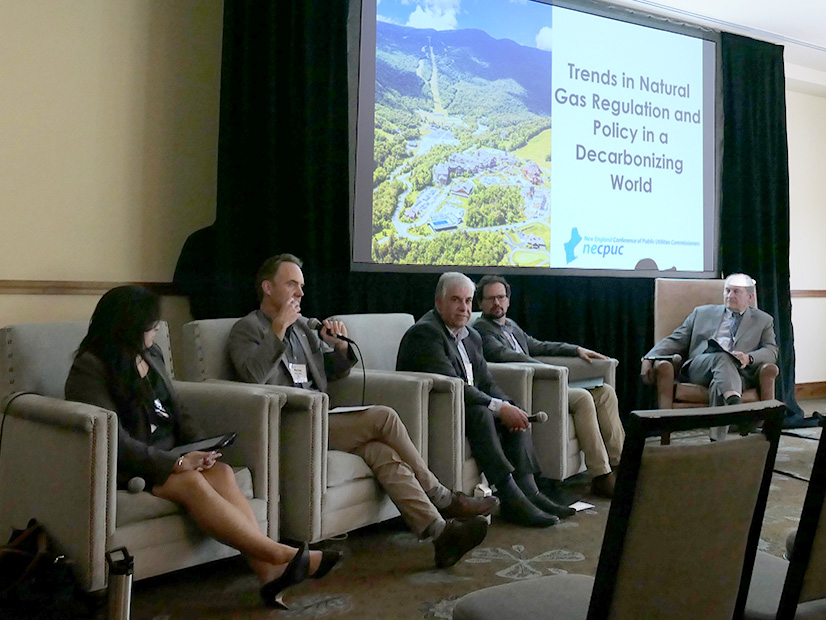
STOWE, Vermont — New England must cut its natural gas use to meet the region’s decarbonization goals, panelists said at the New England Conference of Public Utilities Commissioners (NECPUC) 75th Symposium Tuesday. But there was no consensus on how fast the fuel should be phased out or whether its infrastructure should be repurposed.
The gas network is one of the largest sources of carbon pollution in the region. The Massachusetts Department of Environmental Protection estimates that natural gas accounts for nearly 40% of the state’s emissions from fuel combustion, an estimate that likely undercounts actual emissions by a significant margin because of unmonitored leaks from gas infrastructure.
Natural gas is used to heat about 51% of homes in the state and is also the largest source of electricity generation in New England, accounting for about 52% of the region’s generation.
“The natural gas infrastructure is viable and necessary,” said José Costa, the CEO of the Northeast Gas Association, which represents the region’s gas utilities. “We should push back on those that want to phase out the infrastructure.”
Costa said that he opposes efforts to ban gas hookups in new buildings, a movement that has been gaining steam in Massachusetts, which authorized 10 municipalities to implement gas bans for most new building construction during the state’s previous legislative session.
“You should have choice there,” Costa said.
Mackay Miller, a partner at consultant ERM and the former director of U.S. strategy at National Grid (NYSE:NGG), disagreed with Costa, saying that states with mandatory emissions reductions targets should ban new gas interconnections. “By 2030 approximately, there should be ratepayer protections in place; there should be exemptions for critical facilities and other potentially industrial commercial customers where there’s no comparable substitute service,” he said.
“Every country that is on track for net zero has taken this step already — the U.K., Netherlands — this would not be a huge deal.”
Costa acknowledged that natural gas use must decrease to meet decarbonization targets but argued that it could be replaced with alternative fuels such as renewable natural gas and hydrogen.
Priya Gandbhir, a senior attorney at the Conservation Law Foundation, pushed back on Costa’s characterization of those potential alternatives to natural gas, and said that decommissioning the bulk of the gas system makes the most sense for ratepayers and the environment.
“The evidence just isn’t there that these alternative fuels, hydrogen and biomethane, are up to snuff,” Gandbhir said. “In most circumstances, electrification is more efficient, more cost effective, safer, and more viable.”
Gandbhir said regulators should be “reviewing and prohibiting utility propaganda about the purported benefits of alternative fuels such as renewable natural gas and hydrogen.”
Mark LeBel, a senior associate at the Regulatory Assistance Project, said that accurately assessing emissions associated with the lifecycle of natural gas and alternative fuels will be an important step going forward.
“The leakage in the distribution system, in the transmission system, gas extraction — all that impacts the planet. So, I think at some point we’re going to have to wrestle with some of those questions that we’ve been putting off in some of our environmental regulations,” LeBel said. “When you burn the hydrogen, zero GHG emissions come from the point source. But the question is, where do you get the hydrogen from?”
Miller said that a focus on equity will be important in considering how to decarbonize the system while maintaining its safety, to ensure that cost burdens do not fall on low-income customers.
New England states that have pursued expedited pipeline replacement programs are facing a tension between the mounting costs of these programs and the risks that the infrastructure could become stranded assets as states move away from natural gas.
Miller said that regulators for states with newer, less leak-prone infrastructure “can probably accelerate depreciation or take some other fairly plain vanilla regulatory steps such that by the time you’re at relatively low demand, you’re still within the bounds of affordability.”
For states with older, deteriorating gas systems, he said that regulators are facing a larger task to maintain affordability.
“There you would likely need to be looking at ways to offer capital investment opportunities to utilities that are not going to build up rate base. You need to be looking at ways to bring in other sources of funding to handle the capital expenditure,” Miller said. “We’ve been hearing that there’s some interest at the Department of Energy in supporting some of these safety-related pipeline expenditures. That would provide an interesting opportunity for a bit of a safety release valve on ratepayer bill pressure.”

